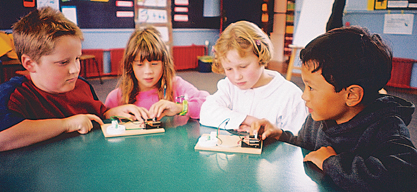![]() PROGRESSION IN LEARNING TECHNOLOGY AT YEARS 4 AND 8
PROGRESSION IN LEARNING TECHNOLOGY AT YEARS 4 AND 8
![]()
Alister Jones, Ann Harlow,
Louise Milne, Judy Moreland and Mike Forret
In
1996 and 2000, NEMP studies of technology provided insights into
students’ understanding of and performance in technology
tasks. These and classroom-based research over four years have
allowed us to develop notions of how students progress in their
technology learning. The in-depth study of students’ performance
on NEMP technology tasks reported here was undertaken to provide
an even clearer picture of the ideas and skills that students
bring to learning in technology and of the possible technology
learning outcomes afforded by the NEMP tasks. |

An
in-depth analysis was conducted of student performance on each NEMP task.
A sample of 30 student responses for each task was then considered in
relation to the following:
• The value of the task in terms of its holistic aspects, generic
and specific conceptual and procedural aspects, and its societal and technical
aspects.
• Characteristics of students’ existing knowledge and skills
in terms of how many technology-related variables the students could identify,
how they applied these variables (whether individually or in combination),
what their technological understanding was, and how they handled conflicting
demands in finding a solution to the task.
• The development of students’ technology-related ideas.
| •
The NEMP technology tasks appear to be a valid means of ascertaining
aspects of students’ technology-related knowledge and skills.
• The number and type of variables that students could identify and apply were the best indicators of performance across the tasks. Data for the two year groups (Years 4 and 8) revealed that Year 8 students were more likely than Year 4 to identify and consider a greater number and wider range of variables, the conflicting demands of these, and the relationships between them and the end user. They also were more proficient at using technological language. • Higher performers at both year levels tended to consider more than two variables when comparing and contrasting technologies, to identify the strengths and weaknesses of given materials, and to consider functionality and the intended user. |
•
Students’ drawings elicited more information than written answers
about their technological ideas, including those relating to structural
requirements and functionality. • Students were often unaware of the planning that takes place before technological production or construction. • When thinking about production and sales of a product, the majority of students gave little thought to issues impacting on its sale, health and hygiene-related considerations, the product preferences of consumers, point of sale considerations, and advertising. • More able students considered a greater number of positive and negative effects of technology on a community, on the environment and the social structure than did less able students. |
![]()
This increased understanding of the capabilities that students bring to
tasks and the contexts in which they work on those tasks not only allows
consideration to be given to fast-forwarding particular aspects of student
learning but also assists in designing tasks that maximise student learning.